This required a lot of prep work but the end result was quite satisfying. The pepper really made the dish by providing a zing that cut through the richness of the skin and sauce. I am not sure how this compares with the original but it is a nice dish to start. It is quite a contrast to grilled chicken skin which is also very common yakitori 焼き鳥 affair.
Most recent post
▼
Wednesday, February 29, 2012
Chicken skin simmered in miso 雛皮の味噌煮
I made Nagaimo pancake or "Tororo-yaki" after reading the izakaya blog by Mr. Hamada, who is a semi-professional Izakaya goer. Although he has a day job, several Izakaya books (either authored or edited) are under his belt and he appears in Japanese magazines occasionally discussing Izakaya. He goes to Izakaya almost every night (of course more than one Izakaya or bar on a given night) in Kure 呉, near Hiroshima 広島市 and Tokyo. I get vicarious enjoyment reading his blog. This is another dish I saw in his blog. I just surmised how it was made from his description of chicken skin in miso but I have no idea if what I made is even close. In any case, this was the first small dish I made for dinner on the weekend. My wife and I thought this was great (An appropriate Japanese expression for this will be "Jiga Jisan" 自画自賛 meaning "praising your own painting").
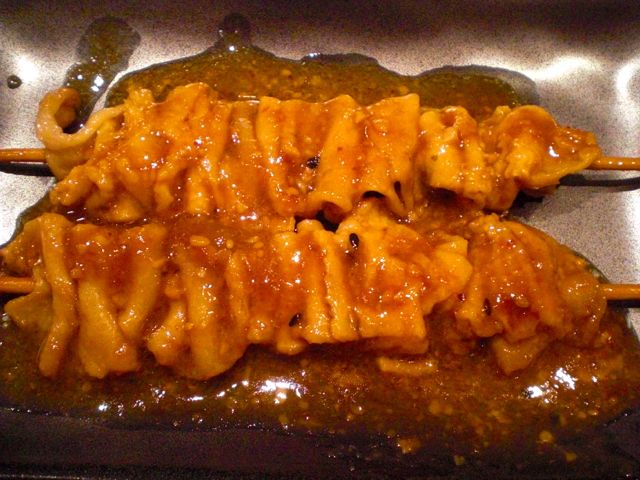
Another reason I made this was that I had 4 chicken thighs. I hand chopped the meat and made a portion of the chopped meat into a Japanese style chicken patty dish called tsukune (left upper in the image below). I made the other portion into chicken cutlets (both will be posted). Since I had the skin left over, rather than throwing it out, I decided to make it into this dish. It is a very lowly dish since chicken skin is almost free but requires some preparation. I first boiled the skins in water with a bit of sake for 10 minutes. I then washed them in cold running water. Using a sharp knife, I scraped off any stubbles of feathers and excess fat from the skin. I then cut the skin into a inch wide strips and skewered them as seen in the right upper of the image below).
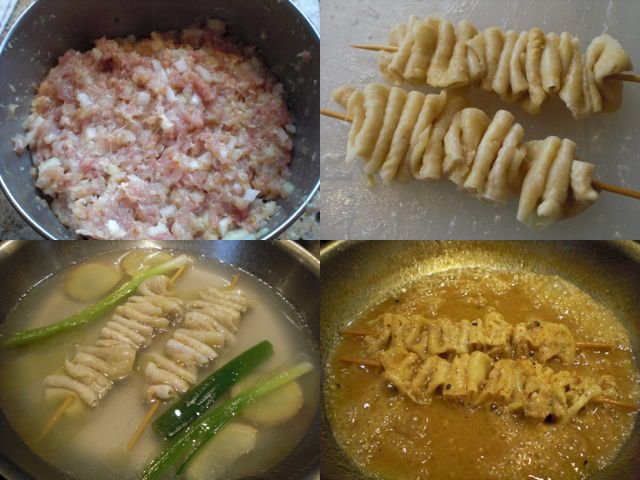
I put the skewers of chicken skin in a frying pan with fresh water and a splash of sake, slices of ginger and scallion as seen in the left lower of the iamge above and simmered it for 20 minutes or so with the lid on. I removed the scallion and ginger. At this point, the liquid is less than 1/4 cup. I disolved miso (1 tsp), sugar (1/2 tsp), sprinkled Japanese 7-flavored red pepper 七味唐辛子 and simmered for another 20 minutes (right lower in the image above) with the lid on. When the miso broth got thick I removed the skewers and lid and reduced it a bit further until it formed a thick sauce.
Monday, February 27, 2012
Baked green bean and carrot with tofu dressing インゲンと人参の白和え
This is another quick dish. When I made steamed tofu stuffed with shrimp and shiitake mushroom, I was left with 5-6 tea spoonfuls of tofu from the area I scooped out to make space for the shrimp stuffing. Using this extra portion of tofu, I made "shira-ae" dressing. "Shira-ae" 白和え means "white dressing". It is usually made with tofu, sesame, soy sauce and sugar, I made this with tofu, miso and mirin.

For the vegetable, I used baked green beans and carrots which my wife made over the weekend. She just coated the vegetables with olive oil, spreaded them out in a single layer on a cookie sheet seasoned with salt and baked in a 350F oven for 30 minutes. Baking vegetables makes them much sweeter than steaming or boiling them.
Shira-ae dressing: I just mixed tofu (5-6 tsp), miso (1 tsp), and mirin (few tsp or add until the consistency is just right).
It took only a few minutes to whip up this dish. If I used a pestle and mortar like a Japanese surikogi 擂り粉木 and suribachi すり鉢, the tofu dressing would have been smoother but I was too lazy at this point. This is healthy and nice dish.
Saturday, February 25, 2012
Steamed tofu stuffed with shrimp and shiitake 海老と椎茸の蒸し豆腐
I tried to make something special for Valentine's day but it was a weekday evening and we did not have much time after we came home. We popped open a bottle of Champagne (blanc de blanc 2004 vintage but I cannot remember which one this was. Very fruity with no yeasty note and we really liked it). After enjoying the Champagne with a snack of nuts, cheese and crackers, I decided to make this dish since I bought the silken tofu from a Japanese grocery store the previous weekend. This is a rather healthy and simple dish which will go well with any drink including Champagne.
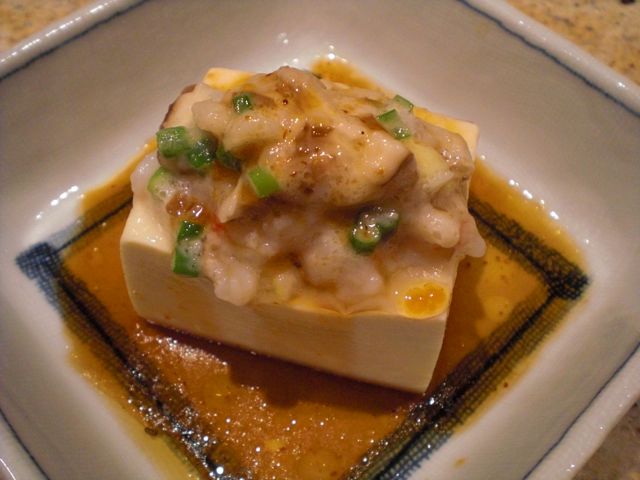
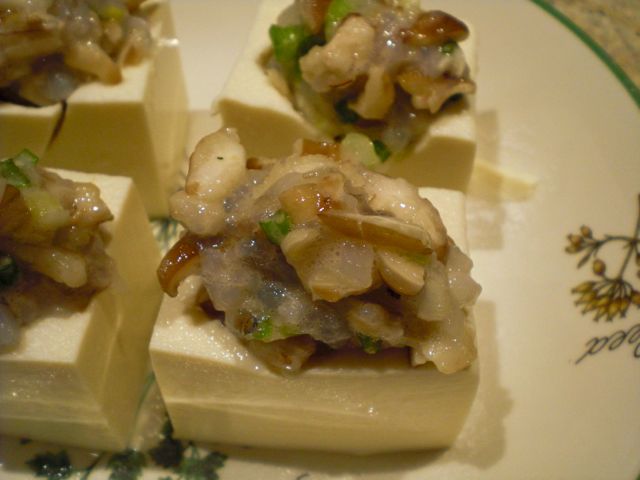
For sauce, I mixed ponzu shouyu (from the bottle), sesame oil (just a dash) and Japanese one-flavor red pepper or ichimi tougrashi 一味唐辛子 and poured it over the steamed stuffed tofu. This is a very gentle nice dish. The flavor of the mushrooms really came through with a pleasant earthiness permeating the tofu. The next day, I microwaved the 2 leftover cubes to warm them up. The dish tasted even better the second day. It also had a better texture for some reason.
The ingredients are; silken tofu (one cut into four), shrimp (6 medium sized frozen, thawed and shell removed and chopped into small pieces), fresh shiitake mushroom (1 large, thinly sliced and chopped) and scallion (one finely chopped).
I mixed all the ingredients in a bowl and added salt (1/4 tsp), egg white (one medium egg), potato starch (about 1 tsp) and mixed well.
I scooped out the center of the tofu cubes with a spoon, making craters just large and deep enough to accommodate stuffing without making a hole through the bottom of the cube. I then sprinkled a small amount of potato starch using a tea strainer on the craters I had just created in the tofu. This helps the stuffing adhere to the tofu.
I gently stuffed the crater and mounded up the shrimp mixture as you see in the picture below. I placed the dish with four squares of stuffed tofu in a steamer (I used an electric wok with continuous steam) for 15 to 20 minutes.
Thursday, February 23, 2012
Deep fried tofu pouch stuffed with chicken and bean sprouts 鶏笹身ともやしの巾着
We were having some very cold and windy days with a bit of snow (just a dusting with some wind-blown snow accumulation). We also had two small abura-age 油揚げ or deep fried tofu pouches left after making inarisuzhi いなり寿司. I decide to make a simplified version of Japanese winter stew or oden おでん. Please see more information in my previosu post for oden. Instead of the usual mochi-kin 餅巾 or mochi rice case in abura-age, I thought I would make pouches stuffed with pork, onion and bean sprouts. Especially since I had leftover blanched bean sprouts from making cellophane noodle salad. Whenever you stuff the abura-age pouch, the dish is caled "kinchaku" 巾着 which is the name for a traditional Japanese pouch. After I started the preparation, I realized I did not have any pork but I had two bone-in skin-on split chicken breasts which needed to be dispatched soon--before they went bad. I removed the breasts and two tenderloins. I made the breasts into microwave "sakamushi" 酒蒸し chicken. I made the stuffing for the tofu pouches from the chicken tenderloins adding shiitake and bean sprouts. The remaining breast bones were used to make the broth for the oden.
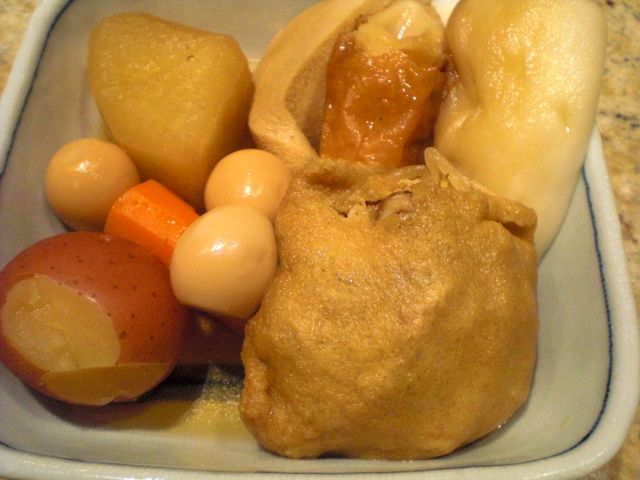
Revealing the content of the pouch.

Broth: I took a shortcut and used a dashi pack with dried fish, bonito flakes, kelp. I also added the bones from the chicken breasts as well (which was not the usual way of making broth for oden). In a pot, I added about 4 cups of water and a dashi pack. After simmering for 5 minutes, I added the chicken bones and simmered for another 20-30 minutes. I skimmed off any scum that appeared on the surface from the chicken bones. After I removed the bones and dashi pack, I strained the broth. I returned the broth to a donabe earthenware pot. I seasoned it with sake (3 tbp), mirin (3 tbs), soy sauce (2 tbs) and usukuchi 薄口 or light colored soy sauce (2 tbs). Later I adjusted the seasoning by adding a bit more light colored soy sauce.
Here is a serving of oden; the stuffed pouch is in the foreground accompanied by diakon, potato, carrot, quail eggs, freeze-dried tofu or shimi-dufu, chikuwa and hanpenn. I admit this does not look particularly photogenic.
Stuffed "kinchaku" pouch: The amounts of the ingredients are not accurate since I did not measure. I made just enough to stuff the two rectangular pouches seen below. I sautéed strips of chicken tenderloin (two), fresh mushrooms (5 small, cut into thin strips), blanched bean sprouts (one handful, probably 1/2 cup) in olive oil with a dash of sesame oil. I also added finely chopped ginger (1/8 tsp) and Japanese red pepper flakes. After few minutes of sautéing, I seasoned it with sake (2 tbs) and soy sauce (1 tbs). I braised it until the liquid was also most all gone.
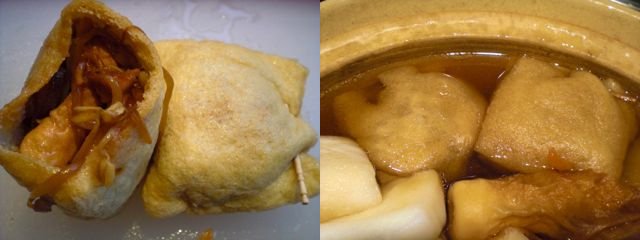
After the stuffing cooled enough to handle, I stuffed the pouches and closed them with a tooth pick (left on the image above). I simmered them in the oden broth with the other items (probably for about one hour. The broth should not boil or even simmer during this process).
Despite the change of plan the midway through, this was not too bad. Although I probably prefer my original intent of bean sprouts, onion, and ground pork, this kinchaku was not bad at all.
Despite the change of plan the midway through, this was not too bad. Although I probably prefer my original intent of bean sprouts, onion, and ground pork, this kinchaku was not bad at all.
Tuesday, February 21, 2012
Cellophane noodle, chicken skin and cucumber salad 春雨と雛皮の和え物
This was a small starter dish one evening. Again, I used what I had at hand to make this simple but tasty dish. The only item I cooked specifically for this dish was the cellophane noodle or "harusame" 春雨. This means "spring rain" which is a poetic name for Japanese-style cellophane noodles. Although this noodle is originally Chinese, the Japanese version is made from potatoes and corn starch (instead of mung bean startch). The other ingredient in the salad was the microwave "sakamushi" chicken which I made the day before. The blanched bean sprout was leftover from making the "kinchaku" oden dish.
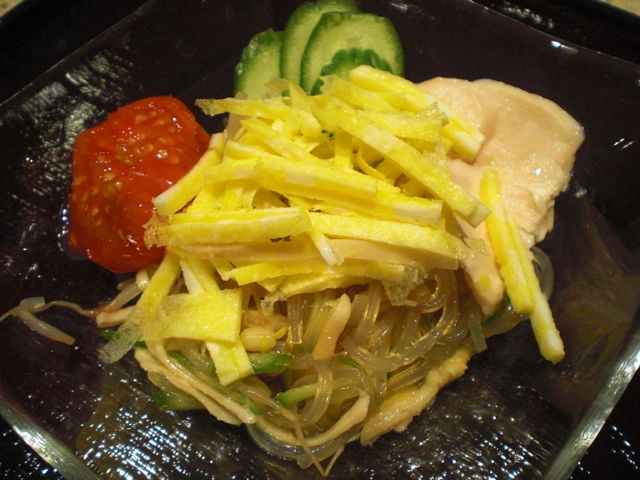
Noodle: On the left is a package of "harusame" noodle. It is dried and comes as brittle white straight noodles but once it is cooked, it becomes semi-transparent noodle with a unique texture--somewhat slippery, soft yet al dente. (The package touts "mochi mochi" mouthfeel). This noodle can be used in soup, nabe, or braised or stir-fried dish. The initial cooking needs to be adjusted depending on how you use it. In my case, I used it in a salad. So, I cooked it fully (about 7 minutes) in boiling water. I drained and washed the noodles immediately in cold running water. I cut the noodles into three segments for the ease of eating. The amount of noodle is totally arbitrary but I used 1/4 of the package. When cooked, the volume of the noodle increases about 4-5 fold.
Cucumber: I washed, salt-rubbed, washed again one American mini-cucumber and sliced it on a slant thinly first. I then julienned it. I salted, kneaded and squeezed out the excess moisture.
Bean sprout: Mung bean sprouts blanched which was leftover from making "kinchaku" oden item. I had about 1/2 cup.
Golden thread egg: This is an extra but I decided to make "kinshiran" 金糸卵. I used one egg beaten and seasoned with salt. I made a very thin omelet by cooking it on a very low flame using a non-stick frying pan coated with a small amount of vegetable oil and with the lid on. After it finished cooking, I cut it into 4 strips and then julienned.
This is a perfect small Izakaya dish to start. You could used chile oil instead of tabasco and sesame oil but this combination is one I always use in leu of chile oil. The combination of the noodle and bean sprout created very good textures and the chicken skin added favor. For instant dressing, the subtle heat from Tabasco and sesame flavor are excellent.
The amounts are all arbitrary but we had about 4 servings of the salad by the time I finished it (small servings as seen above).
Noodle: On the left is a package of "harusame" noodle. It is dried and comes as brittle white straight noodles but once it is cooked, it becomes semi-transparent noodle with a unique texture--somewhat slippery, soft yet al dente. (The package touts "mochi mochi" mouthfeel). This noodle can be used in soup, nabe, or braised or stir-fried dish. The initial cooking needs to be adjusted depending on how you use it. In my case, I used it in a salad. So, I cooked it fully (about 7 minutes) in boiling water. I drained and washed the noodles immediately in cold running water. I cut the noodles into three segments for the ease of eating. The amount of noodle is totally arbitrary but I used 1/4 of the package. When cooked, the volume of the noodle increases about 4-5 fold.
The sakamushi or sake-steamed chicken: I removed the skin of one breast and thinly sliced. I also sliced the meat (3 slices per serving).
Cucumber: I washed, salt-rubbed, washed again one American mini-cucumber and sliced it on a slant thinly first. I then julienned it. I salted, kneaded and squeezed out the excess moisture.
Bean sprout: Mung bean sprouts blanched which was leftover from making "kinchaku" oden item. I had about 1/2 cup.
Golden thread egg: This is an extra but I decided to make "kinshiran" 金糸卵. I used one egg beaten and seasoned with salt. I made a very thin omelet by cooking it on a very low flame using a non-stick frying pan coated with a small amount of vegetable oil and with the lid on. After it finished cooking, I cut it into 4 strips and then julienned.
Dressing: This is an instant dressing made of ponzu souyu ポン酢醤油 (from the bottle, about 3 tbs), dark sesame oil (about 1 tsp), and tabasco (to taste).
I dressed everything except for the golden thread egg. I put the cucumber and chicken slices in a shallow bowl and served the salad in the middle and garnished it with the golden thread egg.
This is a perfect small Izakaya dish to start. You could used chile oil instead of tabasco and sesame oil but this combination is one I always use in leu of chile oil. The combination of the noodle and bean sprout created very good textures and the chicken skin added favor. For instant dressing, the subtle heat from Tabasco and sesame flavor are excellent.
Sunday, February 19, 2012
Sushi in deep fried tofu pouch いなり寿司
When I made chirashi-zushi ちらし寿司, we had leftovers even after I packed lunch boxes for the next day. I made this quick inarizushi いなり寿司 on a subsequent weekday night. This is another type of sushi in which shushi rice is stuffed into deep fried tofu pouchs or abura-age 油揚げ. I posted why dishes using deep fried tofu or abura-age is called "Inari" as in this dish "inari-zushi" or "kitsune" as in "kitsune-soba" きつねそば before. To briefly reiterate, it was said that messengers of the Diety enshrined in Inari-jinja 稲荷神社 are a pair of foxes or kitstune 狐 and somehow it was believed that deep fried tofu was their favorite food.
 The above picture is just to show this was stuffed with seasoned chirashizushi with hijiki, shiitake mushroom, gobou and carrot. Although we sometimes bought inarizushi from the Japanese grocery store, I seldom made it.
The above picture is just to show this was stuffed with seasoned chirashizushi with hijiki, shiitake mushroom, gobou and carrot. Although we sometimes bought inarizushi from the Japanese grocery store, I seldom made it.
In any case, I defrosted 4 small rectangular abura-age called "Inari-age" 稲荷揚げ by pouring hot water over them in a colander. This will defrosts them as well as washes away some of the oiliness which is called "abura-nuki" 油抜き. I pressed the pieces between the paper towels to remove the moisture.
I placed these in a small sauce pan and added water (100ml), mirin (2 tbs) and soy sauce (1 tbs) and simmered for 10-15 minutes turning the inari-age several times until the seasoning liquid was almost all gone. I let it cool down and again pressed the pieces between paper towels to remove the excess moisture. I then cut one end off the pouch and opened it up. Just for decorative purposes, I turned one of the halves in-side-out (left one in the image below)
 You could stuff the pouch with plain sushi rice. This time, I had left over flavored sushi, I microwave it and added a bit more sushi vinegar and let it cool down to room temperature and stuffed the seasoned tofu pouches. You could buy pre-seasoned tofu pouches in a Japanese grocery store (I think they are frozen) but I never used them myself. I served it with my cucumber, diakon and carrot asazuke 浅漬け and "gari" ginger.
You could stuff the pouch with plain sushi rice. This time, I had left over flavored sushi, I microwave it and added a bit more sushi vinegar and let it cool down to room temperature and stuffed the seasoned tofu pouches. You could buy pre-seasoned tofu pouches in a Japanese grocery store (I think they are frozen) but I never used them myself. I served it with my cucumber, diakon and carrot asazuke 浅漬け and "gari" ginger.
My wife thouhgt this was great. Stuffing it with seasoned chirashizushi made this dish much more savory than the simple white sushi rice version. She even thought the two tasted different but, as I mentioned, the only difference was that one pouch had been turned inside out. Even after making the inarizushi, we still had some flavored sushi rice left.
Friday, February 17, 2012
Natto, avocado and tofu on Belgian endive チコリの納豆、豆腐とアボカドの乗せ
Sometimes, what we have dictates what I can make. I bought 4 avocados last weekend but all of them were now quite ripe. If I missed this moment of avocado perfection, they would become mushy, start developing blemishes in a hurry and guacamole would be inevitable. Of course, just nanoseconds before this moment, they were rock hard. In fact, two of them had passed into guacamole land. Another graced a sandwich for the next day's lunch. I made this dish from the last avocado. I came up with this dish since I happened to have a small container of Otokomae tofu and frozen natto in the freezer. In addition, my wife, after many years of abstention, has now come around to eating natto.
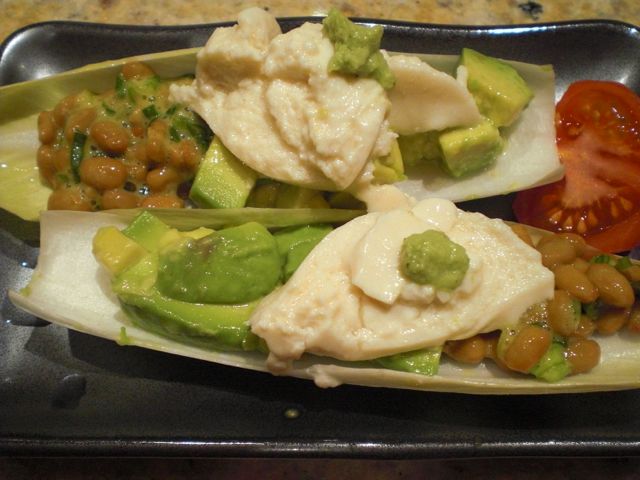 This is a simple spur-of-the-moment quick dish. Did I tell you I also had Belgian endive? (which is called "Chikori" or chicory in Japan. Chicory in the U.S. usually means a root of this plant which is used as a coffee substitute or additives).
This is a simple spur-of-the-moment quick dish. Did I tell you I also had Belgian endive? (which is called "Chikori" or chicory in Japan. Chicory in the U.S. usually means a root of this plant which is used as a coffee substitute or additives).
In any case, this is not a recipe. I just prepared nattou as usual using the seasoning liquid and mustard packets that came with the natto. I just added chopped scallion and mixed it using my nattou mixing contraption well. I removed the stone, skin and cubed the avocado and dressed it with lemon juice and placed the pieces on the endive leaves. I added a few small scoops of soft otokomae tofu and placed a dab of real wasabi on top. Just before eating, we sprinkled on soy sauce and mixed with a small spoon. We ate this with our fingers; picking up the endive leaves. (A word of advice: Start eating from the soft tip of the leaves, otherwise, the leaves will not hold the contents. You do not want to spill nattou on your shirt).
This is not bad at all. The combination of avocado, silken tofu, and nattou is remarkably good. With nattou, sake is the recommended libation.
Wednesday, February 15, 2012
Black vinegar soy sauce simmered chicken 鶏もも肉の黒酢煮
This is just a variation on what I posted before. This time, I added potatoes, carrot and broccoli and served it like "nitsuke" 煮付け or a Japanese traditional stewed dish.
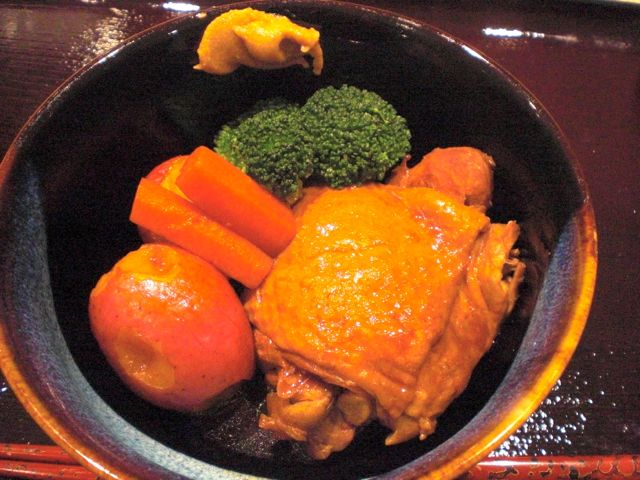
As I have mentioned before, I simmered/steamed chicken breast in a mixture of black vinegar (Japanese not Chinese variety), mirin and soy sauce which was called Kurosuni 黒酢煮. I expanded this to include chicken wings and then chicken thigh in the same sauce. I was initially discarding the leftover broth after the chicken meat was consumed. Then, instead of discarding the broth every time, I added water (to compensate for any evaporation during cooking) and added more soy sauce, black vinegar and mirin (1:1:1 ratio) and reused the broth. I strained the broth between uses and also started adding slices of ginger root (fresh ginger root for every batch discarding the old spent ones). I also changed the way I cook the chicken. instead of cooking it and eating it the same day, I now cook it but eat it later. For example, on the first day, I cook the chicken parts in the broth, then let it cool down and put it in the refrigerator. The next day or few days later, I reheat it. This multi-day process provides a few benefits. One of them is that the chicken becomes much more flavorful and tender as a result of it's extended bath in the liquid. The other is that I can skim off the excess chicken fat.
 The above picture on the left is after an over night in the refrigerator. I remove the chicken fat using a large spoon (of course, if you are so inclined, you could save it and use it as "schmalz".) After removing the fat (on the right), the broth is completely jelled because of the collagen and protein leached into the broth from the chicken--many batches of which were cooked in the broth. This gellee could be used as a dressing by cutting it into small cubes.
The above picture on the left is after an over night in the refrigerator. I remove the chicken fat using a large spoon (of course, if you are so inclined, you could save it and use it as "schmalz".) After removing the fat (on the right), the broth is completely jelled because of the collagen and protein leached into the broth from the chicken--many batches of which were cooked in the broth. This gellee could be used as a dressing by cutting it into small cubes.
To make a complete dish, I have added nagaimo (the sliminess disappears leaving a very nice texture), daikon (I precooked and then finished cooking in the broth), potatoes (I also precooked), and carrot; all worked well.
 Today, I microwaved small red potatoes and placed them in the black vinegar sauce with carrot and simmered them for 20 minutes with chicken thighs. I also added steamed broccoli. I served all these with Japanese hot mustard. So, I have been using the simmering broth for at least several months. The flavor is getting better and better. This time I did not remove the bone from the thigh but we could eat this chicken using chop sticks. The meat was succulent, flavorful and fell right off the bone.
Today, I microwaved small red potatoes and placed them in the black vinegar sauce with carrot and simmered them for 20 minutes with chicken thighs. I also added steamed broccoli. I served all these with Japanese hot mustard. So, I have been using the simmering broth for at least several months. The flavor is getting better and better. This time I did not remove the bone from the thigh but we could eat this chicken using chop sticks. The meat was succulent, flavorful and fell right off the bone.
To make a complete dish, I have added nagaimo (the sliminess disappears leaving a very nice texture), daikon (I precooked and then finished cooking in the broth), potatoes (I also precooked), and carrot; all worked well.
Since the black vinegar is very mild, this dish will go with wine, especially sturdy reds. We had a very reasonably priced (read "cheap") Tempranillo Bodegas Ondarre Reserva Rioja 2004. This is a sort of everyday wine but went well with this dish.
Monday, February 13, 2012
Scattered sushi cooked in Donabe 炊き込み寿司
This is a variation of scattered sushi "chirashizushi or chirashi sushi" ちらし寿司. Scattered sushi can have many different toppings including raw fish (in that case, it is called nama-chirashi 生ちらし or kaisen-chirashi 海鮮ちらし) but the most original form is made with mostly vegetables such as shiitake 椎茸, kanpyou 干瓢, renkon 蓮根, and gobou 牛蒡. The common way to make chirashizushi is to make white rice first, dress it in sushi vinegar and mix in or top with the seasoned cooked vegetables, other items, and garnish.
In this version, I cooked rice and seasoned vegetables together as though I was making flavored rice. After the rice was cooked, I dressed the rice with sushi vinegar and garnished. There is not much difference between this and usual method but this tastes more like flavored rice than classic chirashizushi. I decided to make this after I made "ganmo" since there was excess dried shiitake mushroom and a last bit of gobou remained.
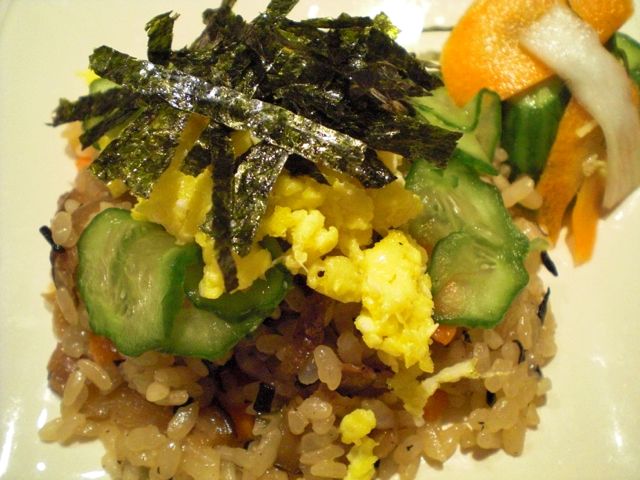 The following amount is for 2 Japanese cups of rice (360ml). The first thing I did was "mis en place" as you can see on the left of the image below. The black thing is "me-hijiki" 芽ひじき about 1/3 cup after hydration, hydrated and sliced shiitake mushrooms (3-4 medium in size), shredded carrot (1/3 medium), gobou (1/4), and abura-age or deep fried tofu pouch (one regular size, cut in small strips).
The following amount is for 2 Japanese cups of rice (360ml). The first thing I did was "mis en place" as you can see on the left of the image below. The black thing is "me-hijiki" 芽ひじき about 1/3 cup after hydration, hydrated and sliced shiitake mushrooms (3-4 medium in size), shredded carrot (1/3 medium), gobou (1/4), and abura-age or deep fried tofu pouch (one regular size, cut in small strips).

I first put dark roasted sesame oil (1 tsp) in a frying pan and sautéed all the ingredients for one minute and added the soaking liquid from the shiitake mushrooms (about 1/2 cup), mirin (2-3 tbs), sake (2-3 tbs) and soy sauce (2 tbs) and simmered it for 20 minutes. I then separated the solids from the liquid (right in the image above). Whatever liquid I collected in the bowl below, I added water (or dashi broth) to make it 400ml.
Meanwhile, I washed the rice (2 Japanese cups, 1 cup=180ml) until the water was no longer turbid and strained it with a strainer.
In Kamado-san donabe rice cooker (or you could use an electric rice cooker), I put the washed rice, the seasoned vegetable mixture and seasoning liquid plus water (400ml) and mixed. As per the instructions that came with the donabe rice cooker, I set the inner and outer lids properly and cooked for 14 minutes on medium flame, turned off the flame and let it stand from 20 minutes without opening.
While I was waiting for the rice to steep, I put about 1/2 cup of sushi vinegar (from the bottle) in a Pyrex measuring cup and heated up by microwaving. After 20 minutes of steeping, I mixed the rice, remove it to a mixing bowl, and dressed it with the sushi vinegar (use as much as the rice could absorb without getting too wet). I let it absorb for 5-10 minutes and served. I made thinly sliced cucumber (American mini-cucu, salted, kneaded and extra moisture squeezed out) and scrambled egg (for two small servings you see here, one large egg seasoned with salt). I also used thin strips of nori as a garnish. On the side, I served asazuke 浅漬け of cucumber, daikon, and carrot.
This was a nice ending dish for the evening. The rice was still warm and has many more flavors in the rice than the regular scattered sushi. I used the leftover rice for lunch boxes the next. Even so, we have a lot left. (Just a head-up that you may be seeing more of this rice in the near future.)
Saturday, February 11, 2012
Cheese stick wrapped in wonton skin チーズのミニ春巻き
When I was growing up this was what my mother used to make as a drinking snack when guests came over. She deep fried this but I just fried all the surfaces using a small amount of oil in a non-stick frying pan (with the hope that this was slightly less deadly than my mother's method).
 Using a scant amount of oil (less than 1 tbs), I fried all four sides in a non-stick frying pan on low heat until all sides are golden and crispy. Depending on the cheese, it may melt or as in the case of smoked cheddar, it may soften but not actually melt much.
Using a scant amount of oil (less than 1 tbs), I fried all four sides in a non-stick frying pan on low heat until all sides are golden and crispy. Depending on the cheese, it may melt or as in the case of smoked cheddar, it may soften but not actually melt much.
The image on the left shows cheese sticks wrapped with wonton skin before being fried. On the right is the finished stick made with aged but not smoked cheddar cheese which melted and puddled in the bottom of the wonton skin. If you use melting cheese, the cheese may leak from the seams of the wonton skin if you are not careful.
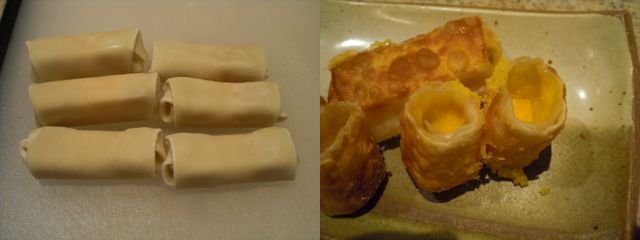
I think this is a fairly common homey dish in Japan. Essentially, this is a cheese stick (Japanese "processed" cheese) wrapped in Gyoza or Wonton skin and fried.
 Here I used smoked cheddar cheese cut into a stick that would just fit the Wonton skin. I wrapped it and sealed the end by moistening it.
Here I used smoked cheddar cheese cut into a stick that would just fit the Wonton skin. I wrapped it and sealed the end by moistening it.
The image on the left shows cheese sticks wrapped with wonton skin before being fried. On the right is the finished stick made with aged but not smoked cheddar cheese which melted and puddled in the bottom of the wonton skin. If you use melting cheese, the cheese may leak from the seams of the wonton skin if you are not careful.
I served this with Dijon mustard. Either the smoked or non smoked cheddar cheeses were good. This type of snacks can't go wrong albeit it may not be too healthy.
Thursday, February 9, 2012
Fried tofu ball がんもどき
Ganmodoki is one of the common items used in oden おでん. Usually I buy this ready made and frozen but since I had 1/2 tofu left over and happened to have the other ingredients to make "ganmodoki" or "ganmo" for short, I gave it a go. Hot freshly fried ganmo is very different from what you eat as an oden item.
Here I served it hot with grated ginger and soy sauce. (You can see a ginko nut peeking out of the cut surface.) There appear to be many theories as to the origin of the name. The corresponding kanji letter for ganmodoki is 雁擬き meaning "imitation goose" but this certainly does not resemble, in any way, shape or form, goose meat.

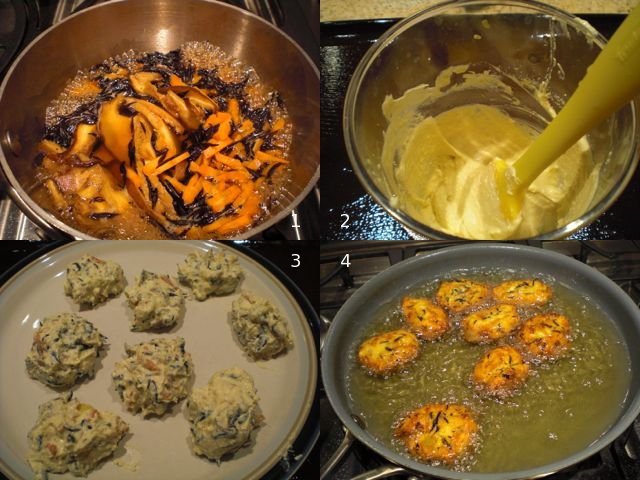 I deep fried it in 170C (340F) vegetable oil until golden (#4, turning a few times, total time of 4-5 minutes).
I deep fried it in 170C (340F) vegetable oil until golden (#4, turning a few times, total time of 4-5 minutes).
I had 1/2 a block of soft tofu to use. I wrapped it in a paper towel and microwaved it for 1 and half minutes and let it cool down, allowing the excess water to be absorbed into the paper towel. I placed the tofu and a whole egg (1 large) in a plastic blending container and homogenized using an immersion blender (#2 in the image below). You can use a food processor or Japanese mortar, suribachi すり鉢, for this as well.
Other ingredients included; dried shiitake mushroom (1 large, hydrated, stem removed and thinly sliced), black sea weed called "hijiki" ひじき (dried 1 tbs), gobou (1/4 tail end, leftover from the New Year) and carrot (1/4 medium). For hijiki sea weed, this time, I used "me-hijiki" 芽ひじき which is shorter and smaller than long hijiki or naga-hijiki 長ひじき I posted before. After hydration (with several changes of water for 30 minutes), hijiki increased in volume by almost 10 fold. I squeezed out the excess moisture and combined with shredded gobout and carrot.* I added the soaking liquid from the shiitake (100ml) and simmered (#1 in the image below). I added mirin (2 tbs) and soy sauce (1 tbs) and further simmered on a low flame for 5-10 minutes until almost all the liquid was gone. I let it cool down and further removed any remaining liquid by squeezing. I added the mixture to the homogenized tofu and added potato starch (1 tsp or a bit more depending on the moisture level) and mixed well. Since I seasoned the vegetables, I did not add salt to the batter.
Moistening my hands with vegetable oil, I made small round disks (eight 2 inch diameter) and I also inserted ginko nuts (from a can) into the center (#3 in the image below). The batter was very soft and sticky. You could use two spoons in a manner similar to making quenelle and directly drop it in the oil.
* These were cut in "sasagaki" ささがき. In Japanese curinary parlance, sasagaki is to shave off vegetables (mostly thin long items such as gobou) as though you are sharpening a pencil. Supposedly, the shape of the resulting pieces resembles small bambo ("sasa" 笹) leaves.
Homemade and hot freshly fried ganmo has an all together different taste and texture from the frozen variety we are used to. Hot and crunchy on the outside you can't go wrong. Although, we have to admit, this does not remind us of goose meat, it is quite good on is own right. A perfect drinking snack especially with cold sake.
Tuesday, February 7, 2012
Rice cake "mini" spring roll 餅のミニ春巻き
I saw this one in e-recipe. I meant to make a similar dish with cheese but I thought this was very interesting and perfect for using up the left over mochi 餅 or rice cake from New Year. I made this one weekend as a starter dish. Since I did not have spring roll wrap or skin, I used an American style square "gyoza" or wonton skin instead.
 The inside has mochi wrapped in a seasoned nori sheet which was smeared with yuzu-koshou 柚子胡椒. I served the rolls on a bed of baby arugula. I poured a small amount of the peanut oil in which the rolls were cooked plus a splash of soy sauce over the arugula to make an impromptu dressing and to slightly wilt it.
The inside has mochi wrapped in a seasoned nori sheet which was smeared with yuzu-koshou 柚子胡椒. I served the rolls on a bed of baby arugula. I poured a small amount of the peanut oil in which the rolls were cooked plus a splash of soy sauce over the arugula to make an impromptu dressing and to slightly wilt it.
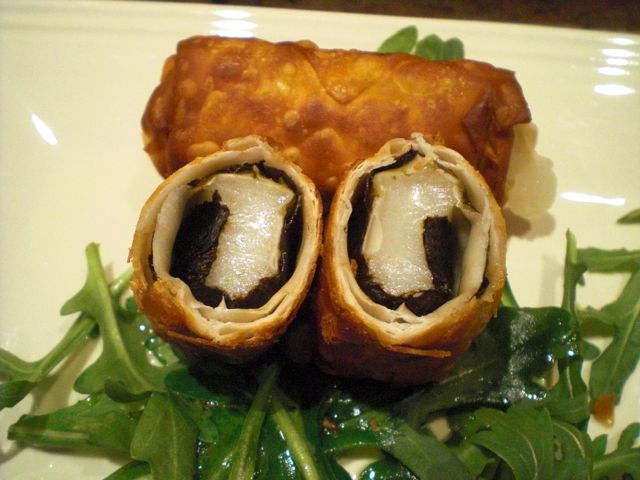 Mochi: I cut a square of mochi or kiri-mochi 切り餅 into 5 equal size sticks.
Mochi: I cut a square of mochi or kiri-mochi 切り餅 into 5 equal size sticks.
 Using a small non-stick frying pan with peanut oil (1 tbs) on low heat (#5). I turned them every 30 seconds or so initially so that all the overlapped skins got cooked evenly and held together (#5). Once all the sides were fried, I let it cook a longer time on one side (1 minute or so on each side) until the skin was brown, crispy, and the mochi was soft (total of 5-7 minutes). When I saw soft mochi starting to come out from the seam and knew it was done (see the very first picture in the beginning of the post).
Using a small non-stick frying pan with peanut oil (1 tbs) on low heat (#5). I turned them every 30 seconds or so initially so that all the overlapped skins got cooked evenly and held together (#5). Once all the sides were fried, I let it cook a longer time on one side (1 minute or so on each side) until the skin was brown, crispy, and the mochi was soft (total of 5-7 minutes). When I saw soft mochi starting to come out from the seam and knew it was done (see the very first picture in the beginning of the post).
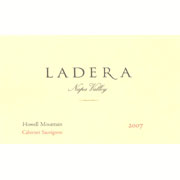 This is a very nice dish. The gyoza skin was very crispy and the mochi was nicely soft but not too soft or too sticky. The nori and yuzu-koshou added some spiciness to the nice flavor. My wife could not figure out what was inside. She thought it was some kind of cheese. This is a very good way to use up left over mochi.
This is a very nice dish. The gyoza skin was very crispy and the mochi was nicely soft but not too soft or too sticky. The nori and yuzu-koshou added some spiciness to the nice flavor. My wife could not figure out what was inside. She thought it was some kind of cheese. This is a very good way to use up left over mochi.
Nori: I just used a prepackaged and precut "ajitsuke-nori" 味付け海苔.
Since, the gyoza skin was a bit too small to wrap the mochi sticks or the nori, I used two together staggered like seen in image #1 below. I moistened the overlapping parts with water so that two sheets would stick together. I placed the nori on the gyoza skin (#1) and smeared Yuzu-koshou on the nori then put on the mochi stick (#2). As I rolled I moistened the overlapping gyoza skin and made tightly wrapped mochi sticks (#4).
This dish will go with any drinks but we happened to be having Ladera Howell mountain Cab 2007. This wine was an excellent California Cab (I will give 91-92) but it is overhyped and 2007 may not be the best year for them. At this price point, it is not cost effective (low PQR or Price-Quality-Ratio). We can have a similarly good Cali cab at 1/3 of the price for that matter.
Sunday, February 5, 2012
Soba roll sushi 蕎麦寿司
You may ask, "Why would you make rolled sushi from soba noodles?" I am not sure why but the answer may be because we can or this is a more portable form of soba. For example, you could take this one more easily than traditional soba as a lunch. In any case, I had left over seasoned kanpyou かんぴょう and shiitake mushroom 椎茸 from making "futomaki" 太巻き roll and decide to make this dish. I have made it several times in the past and have seen recipes in a Japanese noodle cook book (in English) but two crucial pieces of information or steps, in my opinion, are missing. So I decided this is a good time to share how I assemble sobazushi 蕎麦寿司. This was an endng dish one evening.
 Preparing kanpyou, dried shiitake mushroom, Japanese omelet, and spinach is described in the roll sushi post.
Preparing kanpyou, dried shiitake mushroom, Japanese omelet, and spinach is described in the roll sushi post.
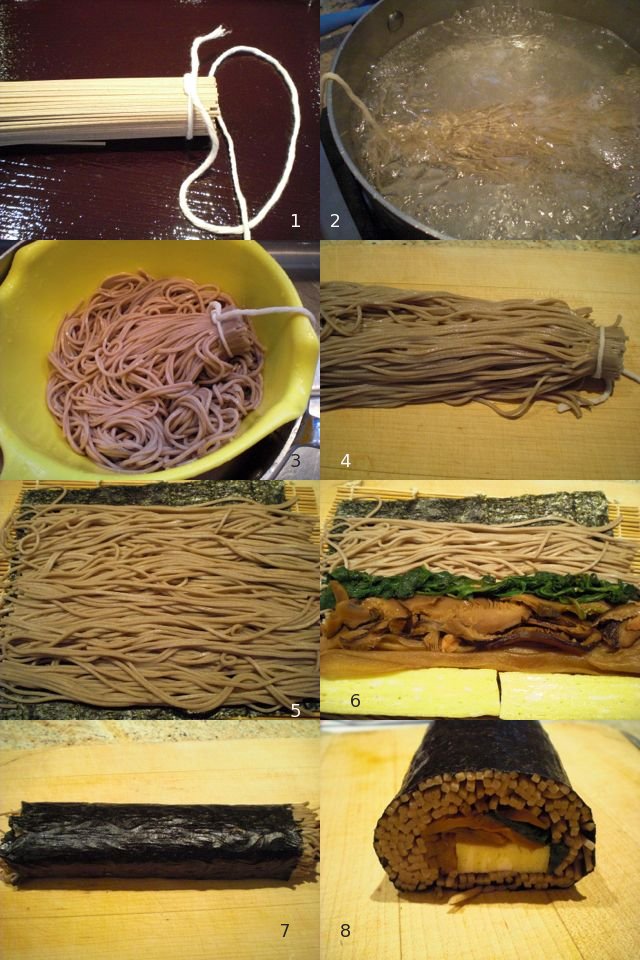 After the noodles have rested and are slightly drier, I spread the noodles on a sheet of nori (#5). I first placed the bundle of noodles on the nori sheet with the tied end still intact. Once the noodles were in place, I cut the tied end (the noodles were still dry and uncooked in the very center of the tied end) and spread it evenly leaving about half an inch of nori sheet in the far end (#5). Like regular futomaki, I placed the omelet, kanpyou, shiitake mushroom and spinach near the edge of the nori sheet (#6). Using a sushi mat, I rolled it to make sure the end of nori sheet is over wrapping. At this point, I did not take off the sushi mat but just let it sit for 5-10 minutes before removing the sushi mat so that the moisture from the noodles made the ends of nori sheet adhere (#7) and the noodles did not fall apart. I cut off both ends of the roll for a snack for my wife and I (#8).
After the noodles have rested and are slightly drier, I spread the noodles on a sheet of nori (#5). I first placed the bundle of noodles on the nori sheet with the tied end still intact. Once the noodles were in place, I cut the tied end (the noodles were still dry and uncooked in the very center of the tied end) and spread it evenly leaving about half an inch of nori sheet in the far end (#5). Like regular futomaki, I placed the omelet, kanpyou, shiitake mushroom and spinach near the edge of the nori sheet (#6). Using a sushi mat, I rolled it to make sure the end of nori sheet is over wrapping. At this point, I did not take off the sushi mat but just let it sit for 5-10 minutes before removing the sushi mat so that the moisture from the noodles made the ends of nori sheet adhere (#7) and the noodles did not fall apart. I cut off both ends of the roll for a snack for my wife and I (#8).
Preparing soba noodle: I used packaged dried soba noodle (#1). The first secret is to tie off one end with bucher's twine. I left enough length of the twine on one end after making a knot. I then cooked the noodles in boiling water but I kept the end of the twine outside the pan (#2) Be careful not to set the twine on fire, though. You could put the end of the twine in the water and later fish it out. I loosened the noodles as they became more pliable using a pair of cooking chopsticks. After the noodles are cooked, I pulled the end of the twine to lift them out of the water and washed it under cold running water but took care not to break the tied end (#3). After I aligned the noodle in one bundle (#4), I squeeze the extra moisture using paper towel. The second secret is to let it sit on the cutting board loosely covered with a plastic wrap for at least 30 minutes or 1 hour before rolling it. If you try to roll it immediately, the noodles have too much water on the surface and just fall apart.
After slicing the roll like a futomaki, I served the pieces with a side of vinegared "gari" ginger and a dab of real wasabi. I served a dipping sauce (diluted from the bottle of a noodle sauce) in a shallow bowl with a wide-opening instead of a regular soba noodle dipping bowl. So that you could dip the roll of soba more easily.
This is definitely much easier to eat than slurping the soba noodles; granted, slurping may be an important part of enjoying soba. The combination of all the different tastes in one mouthful is kind of nice. Is it worth the effort? Maybe on certain occasions.
This is definitely much easier to eat than slurping the soba noodles; granted, slurping may be an important part of enjoying soba. The combination of all the different tastes in one mouthful is kind of nice. Is it worth the effort? Maybe on certain occasions.
Friday, February 3, 2012
Hamachi tartar with miso, parmesan cheese and walnuts ハマチのなめろう
I have posted namerou なめろう made from tuna sashimi. Here I made a similar dish with some additional twists using hamachi sashimi.
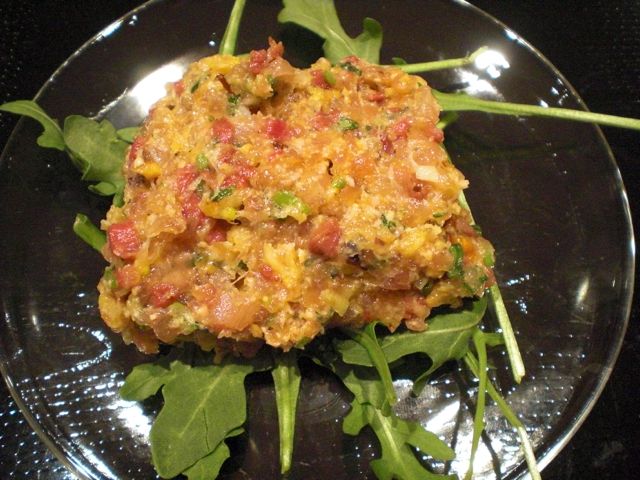 Ingredients included; Hamachi sashimi, scallion, fresh mint, miso, grated ginger and garlic, toasted and chopped walnuts, and grated parmesan cheese.
Ingredients included; Hamachi sashimi, scallion, fresh mint, miso, grated ginger and garlic, toasted and chopped walnuts, and grated parmesan cheese.
These ingredients were chopped together (scallion, mint leaves, and walnuts were pre-chopped). The amount of the ingredients are all arbitrary. I came up with this primarily because we did not have perilla but we did have mint. Since I was using mint, I decided to introduce more Western ingriedients such as walnuts and parmesan cheese.
This is not bad at all but my wife felt that the grated garlic was too strong and dominated the taste. The walnuts (which must be toasted to fully enhance their flavor) gave it a nice textural contrast. The mint was not too strong and parmesan cheese gave it a subtle overtone of cheese flavor. Over all, this qualified as a success (even with the garlic). Although, next time, I will definitely omit garlic. I often have the characteristic problem of continually adding other stuff to this type of dish. Even this time, I thought about putting in lemon zest, sesame oil, Yuzu-koshou, and/or Tabasco but I refrained--next time I may not be so conservative.
Wednesday, February 1, 2012
"Futomaki" roll sushi 太巻き
For the New Year's soup, I usually make mochi kinchaku 餅巾着 or square mochi encased in deep fried tofu pouch or abura-age 油揚げ and tie it off with kanpyou かんぴょう. Since I had extra kanpyou, I decided to make a rolled sushi or "futomaki" 太巻き. Futomaki is a fat roll as compared to "hosomaki" 細巻き which is a thin roll. Futomaki uses a whole sheet of nori instead of a half sheet used for hosomaki.
The regular futomaki roll uses only one whole sheet of nori which is rolled with the rice side in. The version I did here was shown to me by a sushi chef, Hajime はじめ, who worked at a long defunct Japanese restaurant "Mikado" in Tenley town which we frequented in the early years after we moved to DC. Hajime told me that when he makes futomaki in a sushi bar, he first makes an in-side-out roll or uramaki 裏巻き and then wraps it with an additional nori sheet. He said this makes the roll more substantial and sets it apart from homemade rolls. So, I am following his suggestion here.
Ginger: I just used vinegared ginger root like you'll see ar a sushi bar. I just squeezed out the excess liquid and cut it into strips.
My wife made fresh rice perfectly (slightly dry) and I could use a good amount of sushi vinegar. She also fanned the rice while I mixed in the vinegar. I let it stand for 5-10 minutes. I placed the nori sheet with a long axis vertically and spread it with sushi rice (3#). I moistened my hands with slightly vinegared water to prevent the rice from sticking to my hand.
I ususally use a moistened tea towel to make uramaki but, somehow, we could not find it this time. So I used a plastic wrap to cover the rice side (#4). After flipping it over, I placed all the ingredients on the edge closest to me (#5) and started rolling (#6) with the help of a sushi mat and plastic wrap.
The regular futomaki roll uses only one whole sheet of nori which is rolled with the rice side in. The version I did here was shown to me by a sushi chef, Hajime はじめ, who worked at a long defunct Japanese restaurant "Mikado" in Tenley town which we frequented in the early years after we moved to DC. Hajime told me that when he makes futomaki in a sushi bar, he first makes an in-side-out roll or uramaki 裏巻き and then wraps it with an additional nori sheet. He said this makes the roll more substantial and sets it apart from homemade rolls. So, I am following his suggestion here.
What should be included in the center of futomaki rolls is debatable but the must-have items include an omelet, seasoned kanpyou and shiitake mushroom. Vinegared ginger is also a usual item and traditionally red ginger or beni-shouga 紅ショウガ is used but I used "gari" or the kind which is usually served at a sushi bar. Other items may include some kind of protein such as seasoned chikuwa 竹輪 fish cake strips or grilled anago 穴子. Many more modern variations exist including using cooked meat (either pork, beef, chicken, or even Spam - not junk email but Hormel's mystery meat which is called a "luncheon meat", obviously an euphemism, in Japan for some reason). There is pink (artificially dyed) and sweet (almost pure sugar) fish meat product called "sakura denbu" さくらでんぶ, which may be also used (not by me for sure). For greens, I often used pickled cucumber (kasu zuke) but this time I used cooked baby spinach.
Kanpyou: Kanpyou comes dried (sometimes, dried and frozen). I washed it in running cold water. I then rubbed it with Kosher salt in my hands. After washing away the salt, I soaked it in cold water over night in the refrigerator (or several hours at room temperature). If I am going to use it to tie off something, which will be later be further cooked, I do not cook the kanpyou. For a sushi roll however, I simmered it in just enough water to cover with a lid on for 10-20 minutes and seasoned it with mirin and soy sauce. I simmered it until the liquid had almost completely evaporated (another 20 minutes) and let it cool down. I then wrung out the excess liquid.
Shiitake mushroom: You must use dried mushroom, which has more "umami" 旨味 than fresh ones. For sushi roll or scattered sushi or chirashi-zushi ちらし寿司, you need to use dried shiitake. Dried whole mushrooms need to be redydrated in cold water over night or warm water with a pinch of sugar for several hours. After removing the stem, I sliced it thinly. I cooked the sliced re-hydrated mushroom in the soaking liquid for 10-20 minutes and again seasoned it with mirin and soy sauce, simmered it to reduce the liquid to almost nothing, and let it cool. You could also get pre-sliced dried shiitake mushroom, which is a bit more convenient.
Japanese omelet: This is made exactly like a dashimaki だし巻き and then I cut into long strips appropriate for a sushi roll.
Ginger: I just used vinegared ginger root like you'll see ar a sushi bar. I just squeezed out the excess liquid and cut it into strips.
Spinach: I put baby spinach in a dry wok on medium heat with a lid. I turned the partially cooked spinach over a few times until it was completely wilted and seaseon it with salt. I let it cool and squeezed out the excess moisture.
After all these preps were done, I just arranged everythig on a plate (image below #1). I also arranged everything I needed to make a sushi roll, including the sushi vinegar (I could make it from rice vinegar but I ususally use bottled sushi vinegar), "hangiri" or wooden bowl to make sushi rice (#2 right upper corner), nori sheets and sushi mat (#2).
After all these preps were done, I just arranged everythig on a plate (image below #1). I also arranged everything I needed to make a sushi roll, including the sushi vinegar (I could make it from rice vinegar but I ususally use bottled sushi vinegar), "hangiri" or wooden bowl to make sushi rice (#2 right upper corner), nori sheets and sushi mat (#2).
My wife made fresh rice perfectly (slightly dry) and I could use a good amount of sushi vinegar. She also fanned the rice while I mixed in the vinegar. I let it stand for 5-10 minutes. I placed the nori sheet with a long axis vertically and spread it with sushi rice (3#). I moistened my hands with slightly vinegared water to prevent the rice from sticking to my hand.
I ususally use a moistened tea towel to make uramaki but, somehow, we could not find it this time. So I used a plastic wrap to cover the rice side (#4). After flipping it over, I placed all the ingredients on the edge closest to me (#5) and started rolling (#6) with the help of a sushi mat and plastic wrap.
As the rice surface was about to meet the nori sheet, I grabbed the edge of the plastic wrap and lifted it as I was rolling so that the wrap will not be rolled into the sushi roll (Below image #1). Now I have an inside-out roll wrapped in plastic wrap (below image #2). I removed the plastic wrap (below image #3) and place the roll on another nori sheet and rolled it to cover (image below #4).
Here is the end product with both ends already cut off (#5, the ends were a nice snack for my wife and I). With a sharp thin blade, moistened with vinegared water, I sliced the roll (above image #6).
I recruited my wife as a photographer but she complained that I did not pause at the crucial moments for her to take good pictures. In any case, this was a shime dish on a weekend evening. This combination of sushi rice, nori, shiitake, kanpyou and omelet is somehow very comforting and satisfying. I also made a lunch box from the left over for the next day.




